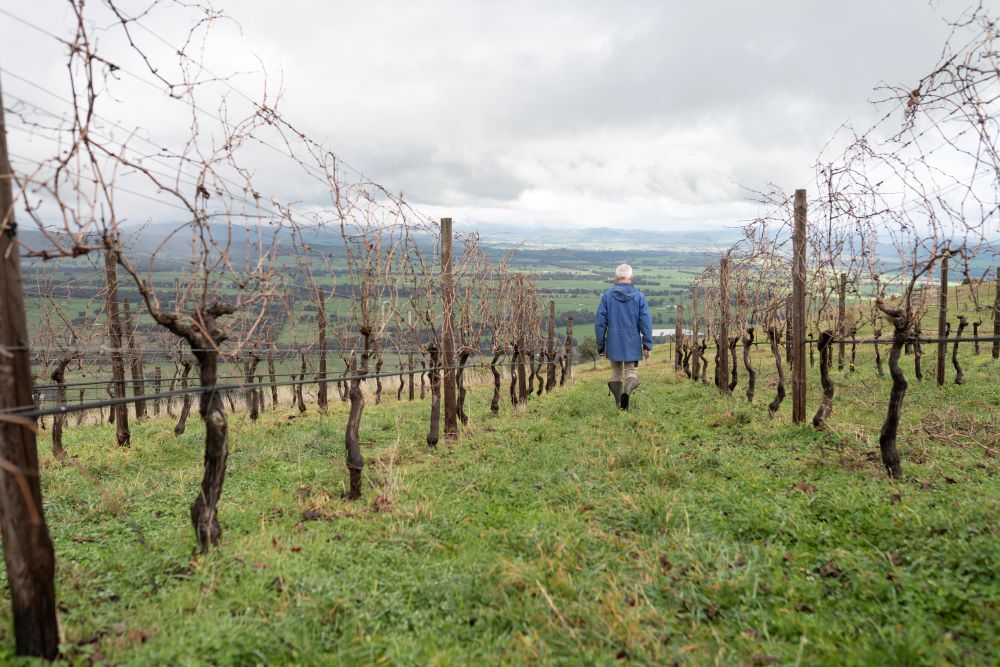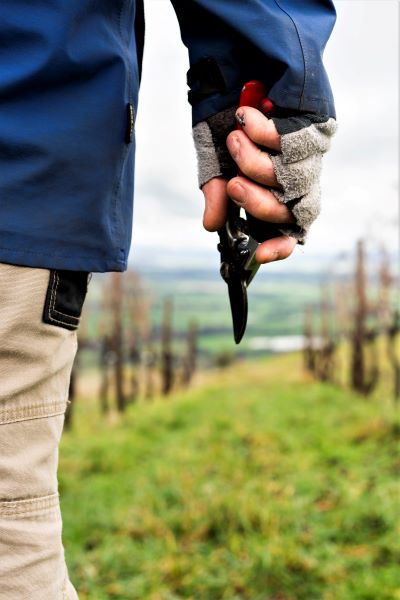The season leading up to the 2023 vintage was, in many ways very similar to the two which preceded it. The winter of 2022 was typified by wet conditions, which didn’t allow many frosts to occur which normally breaks the weather into fine sunny days with cold nights.
Early spring was extremely wet, with budburst occurring as late as yet recorded. The cold conditions resulted in variable budburst which ultimately led to reduced yields in a number of varieties in the 2023 vintage. Late spring was again wet with almost record rains – meaning the staff were almost continuously spraying when conditions allowed, to protect the canopies from downy mildew in particular. We are extremely fortunate to have our vineyards planted on free-draining, shaley Ordovician mudstone soils which allows trafficking at almost any time. This allowed uninterrupted spraying, unlike many vignerons located on the granitic soils who were bogged for weeks on end.
Flowering of the vines was late with a number of varieties occurring in abysmal conditions (read squally winds, wet and cold temperatures). This ultimately resulted in low yields in Chardonnay and Pinot Noir in particular. Later flowering varieties such as Grenache and Tempranillo were spared. A lot of time was spent managing canopies; and leaf plucking in the fruit zone on the morning sun side to allow drying out of the developing bunches as quickly as possible. It kept raining; albeit with a slight reprieve in December (50mm); but then wet again in January (115mm). Fortunately, the critical month of February was moderately dry (21mm) allowing canopies to stop growing and reducing disease pressure, particularly of botrytis. While conditions were never hot (maximum temperatures not exceeding 33⁰C in any month), windy conditions quickly dried the canopies.
Harvest of Chardonnay kicked off in mid-March, a full month later than what has become the new norm of the decade leading up to 2020. The diligent spraying and canopy management put in during the season paid off allowing us to harvest disease-free fruit of extremely high quality. Our newer varieties such as Grenache and Verdicchio were harvested toward the end of April, making us feel confident about their future in a drier, warming environment! The 2023 wines are all excellent in quality. High natural acidities; and high colour in reds. The cool summer conditions were optimum for flavour and colour development. The 2023 Rosé will be bottled shortly, with Pinot Noir, Grenache and Sangiovese to be bottled in early February 2024.
Looking ahead, and taking into account all that the 2023 harvest delivered, our top three to watch would be the 2023 Pinot Noir: The cool and moist growing season was perfect for Pinot Noir at Fighting Gully Road. The enzymes responsible for colour and flavour development have optimal function in the temperature range of 17⁰ to 27⁰C – of which most of the period from verasion to harvest was spent. The resulting wine has intense flavour and romatics, high colour and fine silky tannins, perfect for immediate drinking on release; or medium term cellaring.
2023 Sangiovese: For all the same reasons that Pinot Noir will be a wine to watch, Sangiovese too will be a great wine for immediate enjoyment upon release in autumn next year.
2023 Tempranillo: If your diary goes out far enough pencil this wine in for autumn 2027! New plantings of Tempranillo made at higher plant densities and new clones are coming on stream and the results are incredible. Packed with extra layers of tannin, dense dark fruits and savoury aromatics this wine will be one to watch!
Can’t wait that long? Our picks from our cellared wines, that we’re reaching for this year would include the 2017 Aglianico: Often referred to as ‘the Nebbiolo of the South’, the variety hails from the hills behind Naples, with the best examples found in the regions of Vulture and Taurasi. Due to its natural structure the variety has incredible capacity to age; with our example still exhibiting youthful purple colour and fresh bright red fruits on the nose. While perfect drinking now, you can put a few wines away to enjoy over the next 10+ years at least – and if you’re young, even longer!
2019 Tempranillo: Our wine is crafted in a similar way to those Tempranillo’s found in the Ribera del Duero region of northern Spain; and aged for a full four years from vintage prior to release. Made purely from Tempranillo (no Grenache or Graciano added, like found in Rioja); the wine is aged in 50% new French oak barriques for 18 months prior to bottling. A further two+ years in bottle allows secondary characters to develop prior to release. Like the Aglianico, while perfect drinking now, there is enough structure in the wine to allow for another decade of cellaring this wine.
2019 Syrah: While the variety grows well across the breadth of Australia, it is the wines from the cooler regions which closest resemble those originating in the northern Rhone valley in France. Typically medium bodied, with a component of whole bunch fermentation to add an additional layer of savoury tannins (plus a dash of Viognier), our wine is very much of the same mould. Fermented with one third whole bunches and two percent of pressed Viognier skins, the wine is aged for 18 months in new and used fine grained 600 litre barrels (called demi muids in France). The thick staved barrels allow a very slow ingress of oxygen, so allowing a slow evolution of the tannins while preserving fragrant aromatics, youthful colour and freshness. This wine is drinking perfectly well now, and will be for some years to come.

